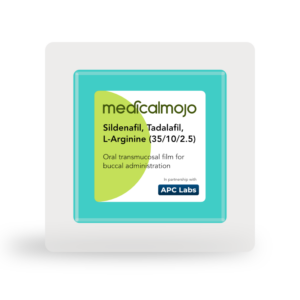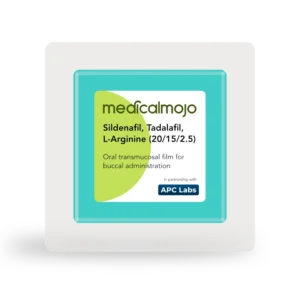When should you take tadalafil or Cialis? Can you take tadalafil daily? With other erectile dysfunction treatments, it is relatively straightforward. With Viagra or sildenafil, you take it half to one hour before sex. But with tadalafil, it’s not as simple. It takes longer to absorb, and the effects last longer. This is why many men ask the question, “When to take tadalafil?”
Before we answer the question of when to take tadalafil, we will go over the basics first. If you feel you have a good grasp of the basics, you can skip to the areas that interest you using the navigational table below.
Table of contents
- What is erectile dysfunction?
- How many men have erectile dysfunction?
- How does an erection occur?
- Causes of erectile dysfunction
- Diabetes and erectile dysfunction
- What is tadalafil or Cialis?
- How does tadalafil or Cialis work?
- The discovery of tadalafil
- How long does tadalafil last?
- What is tadalafil daily?
- Who should take tadalafil daily?
- Who should take tadalafil or Cialis as needed?
- Advantages of tadalafil daily
- Disadvantages of tadalafil daily
- Alternatives to tadalafil
- Can you combine tadalfil and sildenafil?
- Common questions about Tadalafil
- When to take tadalafil summary
- Want to learn more about sildenafil and other erectile dysfunction treatments?
- Need to talk to someone about erectile dysfunction?
-
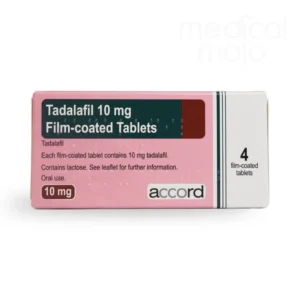 Tadalafil 10mg tablets£8.99 – £31.99
Tadalafil 10mg tablets£8.99 – £31.99 -
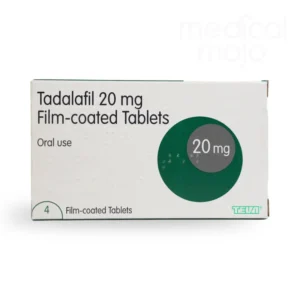 Tadalafil 20mg tablets£8.99 – £32.99
Tadalafil 20mg tablets£8.99 – £32.99 -
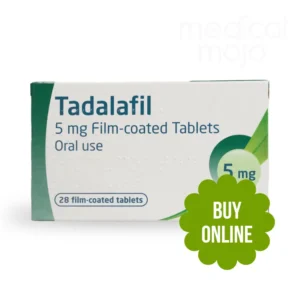 Tadalafil 5mg tablets£17.99 – £45.99
Tadalafil 5mg tablets£17.99 – £45.99
What is erectile dysfunction?
Let’s ensure we are all on the right hymn sheet before addressing the question of when to take tadalafil or Cialis.
Erectile dysfunction, or ED, is defined as when a man cannot get an erection that is firm enough for penetrative sex(Muneer et al., 2014).
It’s not the one-off performance failures that we are concerned with, but rather ongoing erectile dysfunction that has lasted for about six months, which is termed chronic erectile dysfunction.
How many men have erectile dysfunction?
A research study carried out in 2000 estimated that the number of men with erectile dysfunction was about 150 million men. They also speculated that the numbers would increase drastically, and researchers expect that the numbers would reach over 300 million men worldwide (McKinlay, 2000).
So, what is fuelling this massive growth in erectile dysfunction? What worldwide phenomenon is causing such bedroom misery for men? Before we answer this, let’s explore the mechanics of an erection.
How does an erection occur?
Before we discuss the causes of erectile dysfunction, let’s quickly go over how we get an erection in the first place.
Getting an erection is all about blood flow. When more blood flows into the penis than flows out of it, an increase in pressure occurs, leading to an erection. Let’s start to break it down.
The blood vessels are surrounded by smooth muscle; when these muscles relax, blood rushes in, and blood flow slows down when they contract. So, to bring about this relaxation, nitric oxide is released from the lining of the blood vessels, which then causes an increase in the chemical called cGMP, which then acts as a messenger to close calcium channels. Since calcium is required for muscle contraction, having less of it around means that the smooth muscle relaxes, allowing blood to flood the penis (Panchatsharam et al., 2023).
So, in essence, an erection needs good, healthy blood vessels, and anything that damages our blood vessels will make it harder to get an erection.
Causes of erectile dysfunction
So, anything that interferes with the health of our blood vessels can lead to erectile dysfunction. The following long-term conditions have been linked to the increasing rates of erectile dysfunction that we are now seeing (Orimoloye et al., 2019):
- Heart disease,
- High cholesterol, and
- High blood pressure
Diabetes and erectile dysfunction
Another long-term health condition that is a significant contributor to erectile dysfunction is diabetes (Maiorino et al., 2014). The reason is the increased levels of sugar in the blood damage blood vessels making it more difficult to get and maintain an erection (Guay et al., 2007).
What is tadalafil or Cialis?
Tadalafil was originally developed as a heart medicine, but when it was found to improve erections, the focus switched from the heart to the penis.
Tadalafil o Cialis, belongs to the same class of drugs as sildenafil and vardenafil; they are all phosphodiesterase inhibitors. This enzyme breaks down cGMP, the messenger in the body responsible for widening the blood vessels. Without cGMP, the blood vessels constrict, and we lose the erection.
How does tadalafil or Cialis work?
Tadalafil belongs to a type of drug called PDE5 inhibitors, which work by increasing the levels of a cGMP, a chemical responsible for widening the blood vessels (Corbin et al.,2004). When there is more cGMP present, the blood vessels are dilated, allowing more blood to flow into the penis to cause an erection.
Tadalafil increases cGMP levels by blocking the enzyme that breaks it down, phosphodiesterase type 5 (PDE5). What it actually does is that it blocks the effects of PDE5 by competing with cGMP for its binding site. The PDE5 thinks it’s binding cGMP, but it is really binding tadalafil or sildenafil. This is how these PDE5 inhibitors work: by being masters of disguise, tricking the PDE5 into thinking it is really cGMP (Francis et al., 2001).
By blocking PDE5, tadalafil maintains high cGMP levels, dilating the blood vessels, allowing more blood to flood the penis to cause an erection. However, tadalafil or Cialis, still requires the initial sexual arousal to work (Andersson et al., 2018).
The discovery of tadalafil
For all you history buffs, we have included this section on the discovery of tadalafil. Like its blockbuster cousin, Viagra, Cialis, the branded version of tadalafil, started life as a research heart drug. The pharmacologic research company ICOS Corporation, based in Bothell, Washington, was founded in 1990. It started testing a new drug called IC351 for heart-related issues in 1993. Around the same time, another drug, sildenafil citrate (Viagra), was accidentally found to help with erectile function during a study for heart pain treatment in 1994.
IC351 was patented that same year, and its first human trials began in 1995. By 1997, the drug was being tested in men with erectile dysfunction (ED).
In 1998, the year the FDA approved Viagra as the first drug of its kind for erectile dysfunction, ICOS teamed up with Eli Lilly and Company to create Lilly ICOS LLC, aiming to market their new drug better. Initially known as IC351, this drug was officially named tadalafil and branded as Cialis in the year 2000, when they applied for its approval as a new medication (Coward et al., 2008).
How long does tadalafil last?
The unique thing about tadalafil or Cialis, distinguishing it from the other PDE5 inhibitors is its long half-life. This is the time it takes for a drug’s concentration in the blood to reduce to half. While sildenafil or Viagra’s half-life is about 4 hours (Francis and Corbin 2003), tadalafil’s is 17.5 hours, meaning that its effects can last for up to 36 hours (Porst et al., 2003). This is one reason it has been called “the weekend pill.”
What is tadalafil daily?
Tadalafil or Cialis, a type of medication known as a PDE5 inhibitor, works by improving blood flow to the penis to enable an erection. There are two main ways to take Tadalafil for ED: daily low-dose tablets and higher doses taken as needed (ICOS, 2008).
- Tadalafil daily: Available in lower doses (tadalafil 2.5 mg or tadalafil 5 mg), tadalafil daily is designed for consistent, everyday use.
- As-needed tadalafil: Higher doses, such as tadalafil 10 mg or tadlafil 20 mg, are meant to be taken only when required, typically about 30 minutes before sexual activity.
A new and easier way to treat erectile dysfunction (ED) has been developed with tadalafil, which can now be taken just once a day. This change means that men no longer have to time their medication right before sexual activity, a process many found awkward and inconvenient (Hanson-Divers et al., 1998).
Tadalafil has a long half-life of 17.5 hours, making it suitable for daily dosing. This steady dose builds up its levels in the blood within five days, resulting in more consistent effects (Forgue et al., 2006).
In fact, when taken daily, the drug’s concentration in the body is 1.6 times higher than if it’s taken only when needed (Forgue et al., 2006). With this daily regimen, doses of tadalafil 2.5 mg and tadalafil 5 mg eventually mimic having 4 mg and 8 mg in the system, respectively. The FDA approved this daily dosing schedule in January 2008 after detailed studies showed its effectiveness.
Who should take tadalafil daily?
Tadalafil daily is ideal for men who are sexually active three or more times a week and want spontaneous flexibility. The daily dosage offers a continuous effect, so you don’t need to plan around your medication.
If you’re someone who prefers to be ready for sexual activity at any time without the need to take a pill shortly beforehand, tadalafil daily may be more convenient. The continuous low-dose approach can also reduce the chance of common ED medication side effects.
Who should take tadalafil or Cialis as needed?
Tadalafil or Cialis as needed (tadalafil 10 mg or tadalafil 20 mg), is a better choice for men who have sex less frequently or who don’t want the commitment of a daily pill. This choice allows you to take tadalafil only, when necessary, at least 30 minutes before sexual activity.
It’s a flexible choice for men who prefer occasional use and want a longer-lasting effect per dose—one dose of tadalafil can remain effective in the body for up to 36 hours.
Advantages of tadalafil daily
- Spontaneity: With tadalafil daily, you don’t need to worry about timing or carrying a pill with you.
- Reduced side effects: Lower daily doses may help reduce common side effects like headaches, nausea, and back pain.
- Confidence: Knowing that the medication is continuously active can reduce anxiety, especially for those with performance-related stress.
Disadvantages of tadalafil daily
Despite the many benefits of tadalafil daily, it’s not everyone’s cup of tea. Some men may find it unnecessary if they have sex less often, as daily doses can increase overall costs. Additionally, tadalafil daily can take up to 3-5 days to reach its full effect, so it might not deliver immediate results like higher, as-needed doses. Also, there is the discipline required to take the tablet daily.
Alternatives to tadalafil
If tadalafil isn’t the best fit, other erectile dysfucntion medications are available, including:
- Sildenafil (Viagra): The original PDE5 inhibitor is taken as needed and works faster than tadalafil but remains active for about four hours.
- Vardenafil (Levitra) and Avanafil (Stendra): These have the advantage of working faster than tadalafil and sildenafil (Porst et al., 2004).
Can you combine tadalfil and sildenafil?
The short answer is no, if you are taking the licensed sildenafil and tadalafil tablets. But there is a way to take both PDE5 inhibitors together.
If you want an erectile dysfunction treatment that combines the best of both words, and contain short—and long-acting effects of sildenafil and tadalafil, then you are in the right place.
Medical Mojo has compounded a unique triple-combined erectile dysfunction soluble oral patch designed for rapid absorption via the buccal mucosa in the mouth.
The soluble oral patch is attached to the inside of the mouth, against the inner cheek or under the tongue, where it is absorbed directly into the bloodstream, where it can cause an erection within half an hour, with the effects lasting for 36 hours. Check out our YouTube video, “How to use the transmucosal film?”
The soluble oral patch comes in three strengths. So, if you want the flexibility of sildenafil and the confidence of the long-lasting action of tadalafil, try the Medical Mojo triple erectile dysfunction soluble oral patch today.
Common questions about Tadalafil
For tadalafil daily, start with 2.5 mg and adjust to tadalafil 5 mg if needed. The typical starting dose for as-needed use is tadalafil 10 mg, which can be titrated up to 20mg if required.
If you miss a daily dose, take it when you remember but don’t double up. Missing doses may reduce its effectiveness over time.
Tadalafil is intended for those with erectile dysfunction, and taking it unnecessarily can lead to unwanted side effects or even cause dependency. However, research suggests that taking tadalafil daily is useful in those men suffering lower urinary tract symptoms (LUTS) suggestive of benign prostatic hypertrophy (BPH) (Porst et al.,2011).
When to take tadalafil summary
Choosing between tadalafil daily and tadalafil as needed depends on your lifestyle, sexual frequency, and personal preferences. For regular sexual activity (you lucky so and so’s), tadalafil daily can support a spontaneous sex life with fewer interruptions. For occasional use, tadalafil, as needed, provides flexibility and long-lasting effects per dose.
Tadalafil or Cialis, offers a lasting solution for erectile dysfunction, supporting erections for up to 36 hours in many men. It can start working within two hours, and food does not affect its absorption. Maintaining a healthy lifestyle can help maximise the efficacy of tadalafil.
If you are still unsure whether to use tadalafil daily or as needed, please contact us. Our team of ED experts will guide you to suitable treatment.
Want to learn more about sildenafil and other erectile dysfunction treatments?
If you would like to learn more about erectile dysfunction and the various treatments, have a read of informative, evidence-based blogs.
- Why does Viagra cause a headache?
- Why does Viagra cause heartburn?
- Can Viagra cause blood clots?
- Can Viagra cause a stroke?
- Does Viagra make you last longer?
- What is Kamagra?
- Can I drink alcohol while taking sildenafil?
- Can Viagra make you bigger?
- What is Invicorp?
- How long does sildenafil last for?
- How often can you take Viagra? A guide for safe use and effectiveness
- Can you take Viagra with blood thinners?What is Kamagra?
- What is the difference between Viagra and Viagra Connect?
- How long does tadalafil last after taking it?
Need to talk to someone about erectile dysfunction?
Don’t hesitate to discuss erectile dysfunction; think of it as an early alert, like a canary in a coal mine, signalling that there might be other health issues to address. At Medical Mojo, we’re here to support you. We can guide you on the right treatment and offer alternatives if PDE5 inhibitors aren’t effective. We can even tailor a treatment specifically for you. The first step is to get in touch with us, so if you have any questions, please feel free to reach out.
Disclaimer: This article is for informational purposes only and does not replace professional medical advice.
Are weight loss treatments making you tired, or have they led to a sudden increase in hair loss? Do you struggle with sleep?
Get a free month’s supply of one of our compounded treatments for energy, hair loss or sleep, with your first purchase of Mounjaro or Wegovy from Medical Mojo.
Claim your FREE offer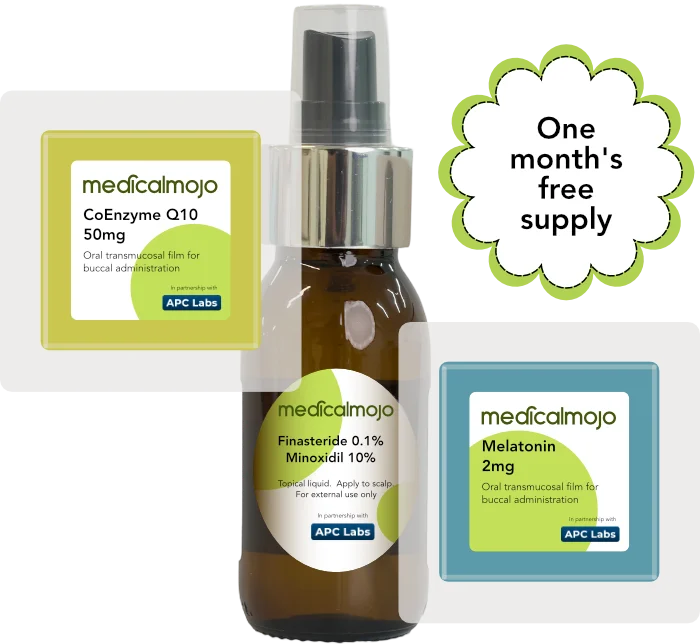
References:
- Muneer A, Kalsi J, Nazareth I, Arya M. Erectile dysfunction. BMJ. 2014 Jan 27;348:g129.
- McKinlay JB. The worldwide prevalence and epidemiology of erectile dysfunction. Int J Impot Res. 2000;12:S6–S11. doi: 10.1038/sj.ijir.3900567.
- Panchatsharam PK, Durland J, Zito PM. Physiology, Erection. In: StatPearls. StatPearls Publishing, Treasure Island (FL); 2023. PMID: 30020650.
- Orimoloye OA, Feldman DI, Blaha MJ. Erectile dysfunction links to cardiovascular disease-defining the clinical value. Trends Cardiovasc Med. 2019 Nov;29(8):458-465.
- Maiorino MI, Bellastella G, Esposito K. Diabetes and sexual dysfunction: current perspectives. Diabetes Metab Syndr Obes. 2014 Mar 6;7:95-105. doi: 10.2147/DMSO.S36455. PMID: 24623985; PMCID: PMC3949699.
- Guay AT. ED2: erectile dysfunction = endothelial dysfunction. Endocrinol Metab Clin North Am. 2007;36(2):453–463.
- Coward RM, Carson CC. Tadalafil in the treatment of erectile dysfunction. Ther Clin Risk Manag. 2008 Dec;4(6):1315-30. doi: 10.2147/tcrm.s3336. PMID: 19337438; PMCID: PMC2643112.
- Corbin JD. Mechanisms of action of PDE5 inhibition in erectile dysfunction. Int J Impot Res. June 2004; 16(1)Suppl 1: S4–7. doi: 10.1038/sj.ijir.3901205, PMID 15224127.
- Francis SH, Turko IV, Corbin JD. Cyclic nucleotide phosphodiesterases: relating structure and function. Prog Nucleic Acid Res Mol Biol. 2001;65:1–52. doi: 10.1016/s0079-6603(00)65001-8.
- Andersson, K.E., 2018. PDE5 inhibitors–pharmacology and clinical applications 20 years after sildenafil discovery. British journal of pharmacology, 175(13), pp.2554-2565.
- Francis SH, Corbin JD. Molecular mechanisms and pharmacokinetics of phosphodiesterase-5 antagonists. Curr Urol Rep. 2003;4:457–65. doi: 10.1007/s11934-003-0027-x.
- Porst H, Padma-Nathan H, Giuliano F, et al. Efficacy of tadalafil for the treatment of erectile dysfunction at 24 and 36 hours after dosing: a randomized controlled trial. Urology. 2003;62:121–5. doi: 10.1016/s0090-4295(03)00359-5.
- ICOS 2008Tadalafil (Cialis) US prescribing informationAccessed June 25, 2008. URL: http://www.lilly.com/us/cialis-pi.pdf
- Hanson-Divers C, Jackson SE, Lue TF, et al. Health outcomes variables important to patients in the treatment of erectile dysfunction. J Urol. 1998;159:1541–7. doi: 10.1097/00005392-199805000-00037.
- Forgue ST, Patterson BE, Bedding AW, et al. Tadalafil pharmacokinetics in healthy subjects. Br J Clin Pharmacol. 2006;61:280–8. doi: 10.1111/j.1365-2125.2005.02553.x.
- Porst, H., 2004. Phosphodiesterase type-5 inhibitors: a critical comparative analysis. EAU Update Series, 2(2), pp.56-63.
- Porst, H., Kim, E.D., Casabé, A.R., Mirone, V., Secrest, R.J., Xu, L., Sundin, D.P., Viktrup, L. and LVHJ Study Team, 2011. Efficacy and safety of tadalafil once daily in the treatment of men with lower urinary tract symptoms suggestive of benign prostatic hyperplasia: results of an international randomized, double-blind, placebo-controlled trial. European urology, 60(5), pp.1105-1113.

